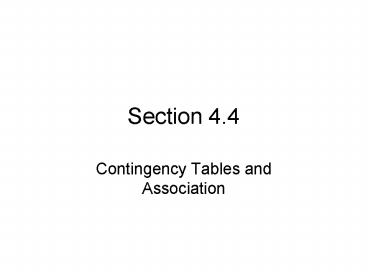Contingency Tables and Association PowerPoint PPT Presentation
Title: Contingency Tables and Association
1
Section 4.4
- Contingency Tables and Association
2
Definitions
- Contingency Table (Two-Way Table) Relates two
categories of data - Row Variable Each row in a table describes a
specific topic, the title of the topics is the
row variable - Column Variable Each column in a table describes
a specific topic, the title of the topics is the
column variable - Cell Each box inside the table is called a cell
3
Example
Education Education Education
Hair Color High School College Graduate
Red 45 33 2
Brunette 90 42 7
Education is our column variable and Hair Color
is our row variable. The high school graduates
with red hair would be in the cell in the first
row, first column
4
Definitions
- Marginal Distribution of a Variable a frequency
or relative frequency distribution of either the
row or column variable in the contingency table
5
Creating a Frequency Marginal Distribution
- Total all the columns and all the rows
- Put a grand total in the bottom right
6
Example
Education Education Education
Hair Color High School College Graduate Totals
Red 45 33 2 80
Brunette 90 42 7 139
Totals 135 75 9 219
7
Creating a Relative Frequency Marginal
Distribution
- Total all the columns and all the rows
- Put a grand total in the bottom right
- Create a new row and column divide each total by
the grand total
8
Example
Education Education Education
Hair Color High School College Graduate Totals Rel. Freq.
Red 45 33 2 80 80/219 0.365
Brunette 90 42 7 139 139/219 0.635
Totals 135 75 9 219
Rel. Freq. 135/219 0.616 75/219 0.342 9/219 0.041
9
Definition
- Conditional Distribution Lists the relative
frequency of each category of the response
variable, given a specific value of the
explanatory variable in the contingency table.
10
Creating a Conditional Distribution
- Total all the columns and all the rows
- Decide if you are studying it by column variable
or row variable - Divide each number inside the table by the
appropriate row or column total that it resides in
11
Example (by Education)
Education Education Education
Hair Color High School College Graduate Totals
Red 45 33 2 80
Brunette 90 42 7 139
Totals 135 75 9
Education Education Education
Hair Color High School College Graduate Totals
Red 45/135 0.333 33/75 0.44 2/9 0.222 80
Brunette 90/135 0.667 42/75 0.56 7/9 0.778 139
Totals 135 75 9
12
Simpsons Paradox
- Describes a situation in which an association
between two variables inverts or goes away when a
third variable is introduced to the analysis.
13
Sex Bias in Graduate Admissions (University of
California)
14
Sex Bias in Graduate Admissions (University of
California)
15
Conclusion
- According to Sullivan The initial analysis did
not account for the lurking variable, program of
study. There were many more male applicants in
programs A and B than female applicants, and
these two programs happen to have higher
acceptance rate. The higher acceptance rates in
these programs led to the false conclusion that
the Univ. of Calif., Berkeley, was biased against
gender in its admissions

